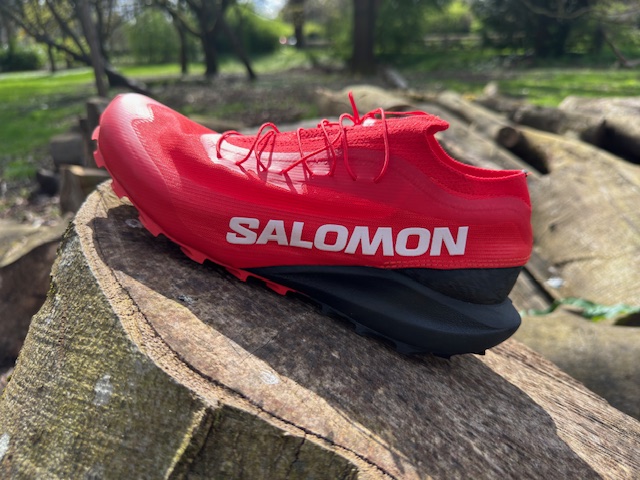Salomon S/Lab Pulsar 3 – Test & Review
"The lugs’ geometry is also sufficiently spaced so it avoids forming a 'mud cake’ easily, helping keeping the grip effective longer."
The Salomon S/Lab Pulsar 3 trail shoes are among the latest additions to the Salomon S/Lab range. S/Lab is not only Salomon’s premium line-up, it’s also where its most innovative products are found, developed for and in collaboration with Salomon’s athletes (such as Courtney Dauwalter and Rémi Bonnet). It’s always exciting to see new S/Lab products.
The Pulsar 3 are super light and perform remarkably well both on technical trails, making them excellent racing shoes for runs of all distances up marathons or short ultras (according to Salomon). The previous Pulsar iteration had two versions, the Pulsar 2 and the Pulsar 2 SG (for soft ground, catering to muddier trails). There’s only one version of the Pulsar 3 being released so far and from my experience testing it, it works rather well on both hard and soft grounds. While I wouldn’t see the need to release a separate Pulsar 3 SG, you never know what Salomon is preparing next.

I did test runs on a wide variety of trail types and technicalities: hard-packed, rocky, grassy, full of roots and other obstacles, dry or overly muddy and even boggy. The shoes inspired me well enough to push the pace harder and take more risks when wearing them even when trails became trickier and distances longer (of a few hours of time on feet).
I eventually tested them hardest on a 50km hilly trail race in the South Downs National Park, which went fairly well with a fast time just outside a podium finish. I will thank the shoes for their contribution to this result!

Out of the box, it’s a shoe that looks minimalistic and, when lifted, feels featherweight. At 200g (size 8 UK, on my kitchen scale), it could be the lightest trail shoe I’ve had the chance to use. I usually see this kind of weight with road super-shoes, not trail ones. Salomon shoes are generally narrow and I’d highlight the Pulsar 3 are narrower than the average Salomon’s. I had to go for a half-size bigger, but once sized right the shoes immediately felt comfortable without pressure points or loose bits.
The Pulsar 3 outsole has a marked rocker shape, providing a dynamic ride and an extra kick to the gait when running fast. It is made of Salomon’s proprietary Contagrip rubber, which provides good traction. It’s also durable, the outsole did not wear out much over the distances I ran the shoes on, noting that I stuck to trails and avoided roads (that would wear out the outsoles potentially faster) whenever I could. The lugs are 4.5mm deep and provide excellent grip on muddy and on gravelly ground. The lugs’ geometry follows a chevron pattern going in opposite directions at the front and at the back of the foot, giving better grip both in the forefoot when climbing and at heel level when speeding downhill on unstable ground. The lugs’ geometry is also sufficiently spaced so it avoids forming a ‘mud cake’ easily, helping keeping the grip effective longer. I might have preferred some more lug depth when running on slippery, high gradient uphill slopes. However, this would have made the shoes less comfortable on most other ground types. The 4.5mm is likely a good compromise.

The midsole is a dual-layered compound of energy foam, of a stiffer kind at the forefoot, contributing to feeling the ground better and being more precise when stepping, especially when it gets technical with obstacles, and of a softer layer at heel level, making the shoe surprisingly comfortable on downhills against impacts. The foam did not compress during long outings or after several outings and the shoes felt fresh throughout. The midsole is moderately thick overall, with a stack of 18mm at the front, 24mm at the back, and a drop of 6mm. Combined with a rock plate, the midsole provides limited cushioning yet what feels like a protective ride with neutral support. The insoles are glued to the shoes.
The upper is what stood out most when I first opened the box. The bright red colour is hard to miss and gives a sharp, fast look. The upper’s shape somehow reminds of ballet shoes (bearing in mind I’ve never worn any, it’s just an impression), being snug and narrow and made out of thin technical materials that are well bound together. The upper wraps the entire foot like a second skin without a separate tongue or tongue gap. This design holds the foot remarkably well. I did not experience my feet rolling sideways while running, it was all stable. The heel area is solid, with extra padding inside provide both comfort and a good lock. My heels never felt loose or slipping out of the shoes, and I did not experience any rubbing or strain on the Achilles area either.

The ankle opening is of a sock-like type: tight and elastic, effectively keeping all debris out. The upper material is made of Matryx mesh, which is light, thin, solid, and hard-wearing yet flexible and breathable. Matryx does not stretch, and the shoes held their size and shape over time during long outings and after many runs. While there is no separate tongue and the whole upper envelops the feet, the lacing area is made of a different material: elastic and knitted, with some padding protecting the feet from the lacing.
Whilst I liked the upper’s design for its look and when wearing the shoes, the Pulsar 3 are hard to put on. The upper’s knitted part in the lacing area has to be stretched out to the max to widen the shoe opening when inserting the foot. There’s a loop on the front to help but it remains tough overall. Having a second loop at heel level would have made putting on the shoes easier without adding much weight to them. Perhaps something to add to the next Pulsar iteration?
The lacing is a typical Salomon ‘Quicklace’ system, with laces that are not tied with a bow but instead tightened or loosened using a little buckle, the excess lace having its own storage pocket (or ‘garage’) so it doesn’t hang around. Quicklace has the advantage of (as its name suggests) being quick to adjust, but also keeps laces secure. There is no random untying or laces catching debris with these shoes. Whereas on some other Salomon shoes it was tricky storing the excess lace in the garage, Salomon positioned it right on the Pulsar 3.

I got fonder and more confident with these shoes after many test runs. Confidence is always paramount when hitting technical trails, not just for safety but also for mere enjoyment of running. No one wants to keep worrying about falling over, or feeling painful feet from uncomfortable shoes after a few hours. Feeling comfortable running at faster pace and taking more risks on tricky trails with the Pulsar 3, I decided to push them harder and use them during a 50km trail race in the South Downs.
The ground on race day was really muddy (sometimes ankle-deep) after a few weeks of endless rain, but riding on it with these shoes was fun. The shoes were stable and I did not slip or lose balance a single time during the event (which is very unlike me). Although my feet got wet (the Matryx mesh is not waterproof), no debris whatsoever came in.
Another positive is that despite the snug fit, I did feel any hot spot and did not catch any blisters. However, it’s impossible for a shoe to perform perfectly on all grounds and while I very much enjoyed using them on trails, they remain stiff and did not feel too bouncy on asphalt, making running on the road a bit of a grind. Fortunately, the race did not have many road sections and the shoes were great overall.
All in, it was a pleasure testing and riding the Pulsar 3s. They are featherlight, fast and comfortable, and they just plain look good. I look forward to hitting more technical trails with them. I would even be tempted to push them over longer distances, maybe for a future 50-mile trail race.
Review by Julien Cazorla
Salomon
S/Lab Pulsar 3
£190









